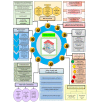Exploring hospitals' functional preparedness effective factors in response to disasters: a qualitative study in a lower middle-income country
- PMID: 38350908
- PMCID: PMC10865653
- DOI: 10.1186/s12913-024-10630-y
Exploring hospitals' functional preparedness effective factors in response to disasters: a qualitative study in a lower middle-income country
Abstract
Background: Medical services are among the most urgent needs of the disaster-affected population. Consequently, hospital preparedness -as the main health services provider- is one of the vital factors in effective response to disasters. The present study aims to explore the perspectives of study participants about the influential factors of hospital functional preparedness in a lower middle-income country.
Methods: In this qualitative study, data were collected through 17 semi-structured interviews with disaster management authorities selected by purposive sampling. Content-Analysis was used to analyze the data.
Results: 138 codes were developed and categorized into ten categories and 34 subcategories. The main categories were: 1- leadership, command, and coordination (4 subcategories); 2- risk assessment (3 subcategories); 3- legislating and developing protocols, guidelines, and programs (3 subcategories); 4- estimating and storing the necessary supplies and equipment (3 subcategories); 5- human resource management (4 subcategories); 6- education, training, and development of staff (6 subcategories); 7- vital routes and facilities (3 subcategories); 8- communication (3 subcategories); 9- security, safety and locating of safe zones (3 subcategories); 10- underlying disaster risk factors (2 subcategories).
Conclusion: According to the participants of this study, ten categories of factors can affect hospitals' functional preparedness; hospital managers and decision-makers can consider these factors to ensure the proper provision of medical services during disasters.
Keywords: Disaster; Disaster Medicine; Functional preparedness; Hospital; Response.
© 2024. The Author(s).
Conflict of interest statement
There is no conflict of interest relevant to this article.
Figures
Similar articles
-
Experiences of operating room nurses in disaster preparedness of a great disaster in Iran: a qualitative study.BMC Emerg Med. 2023 Nov 23;23(1):138. doi: 10.1186/s12873-023-00903-w. BMC Emerg Med. 2023. PMID: 37996807 Free PMC article.
-
Qualitative Study of Health System Preparedness for Successful Implementation of Disaster Exercises in the Iranian Context.Disaster Med Public Health Prep. 2022 Apr;16(2):500-509. doi: 10.1017/dmp.2020.257. Epub 2020 Oct 7. Disaster Med Public Health Prep. 2022. PMID: 33023696
-
Rural hospital incident command leaders' perceptions of disaster preparedness.BMC Emerg Med. 2025 Mar 18;25(1):45. doi: 10.1186/s12873-025-01201-3. BMC Emerg Med. 2025. PMID: 40102726 Free PMC article.
-
Disaster Preparedness among Health Professionals and Support Staff: What is Effective? An Integrative Literature Review.Prehosp Disaster Med. 2017 Jun;32(3):321-328. doi: 10.1017/S1049023X1700019X. Epub 2017 Mar 16. Prehosp Disaster Med. 2017. PMID: 28300525 Review.
-
Factors Affecting the Functional Preparedness of Hospitals in Response to Disasters: A Systematic Review.Bull Emerg Trauma. 2023;11(3):109-118. doi: 10.30476/BEAT.2023.97841.1414. Bull Emerg Trauma. 2023. PMID: 37525651 Free PMC article. Review.
Cited by
-
Diabetes and natural and man-made disasters: prevention, preparation, response and recovery.Diabetologia. 2025 Apr 15. doi: 10.1007/s00125-025-06406-6. Online ahead of print. Diabetologia. 2025. PMID: 40234304 Review.
References
-
- Bani Hashemi SASF. Assessment of climate change and its effects in Iran. Jungles and Grasslands. 2012;94(95):5–10.
-
- Jahangiri K, TABIBI S. Disaster management: designing a new model for effective planning in bioterrorism. 2003.
-
- Yarmohammadian M, Nasr Isfahani M, Anbari E. Assessment of preparedness and response of teaching hospitals of Isfahan, Iran, to chemical, biological, radiological, and nuclear incidents. Health Inf Manag. 2016;12(6):777–84.
-
- CRED.: 2021 Disasters in Numbers. In. Brussels; 2022.
MeSH terms
LinkOut - more resources
Full Text Sources
Medical


